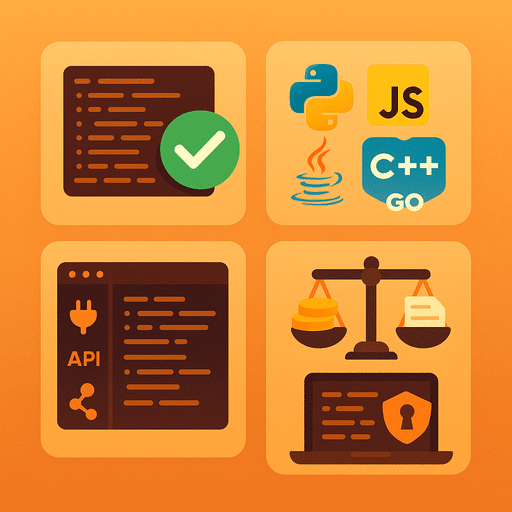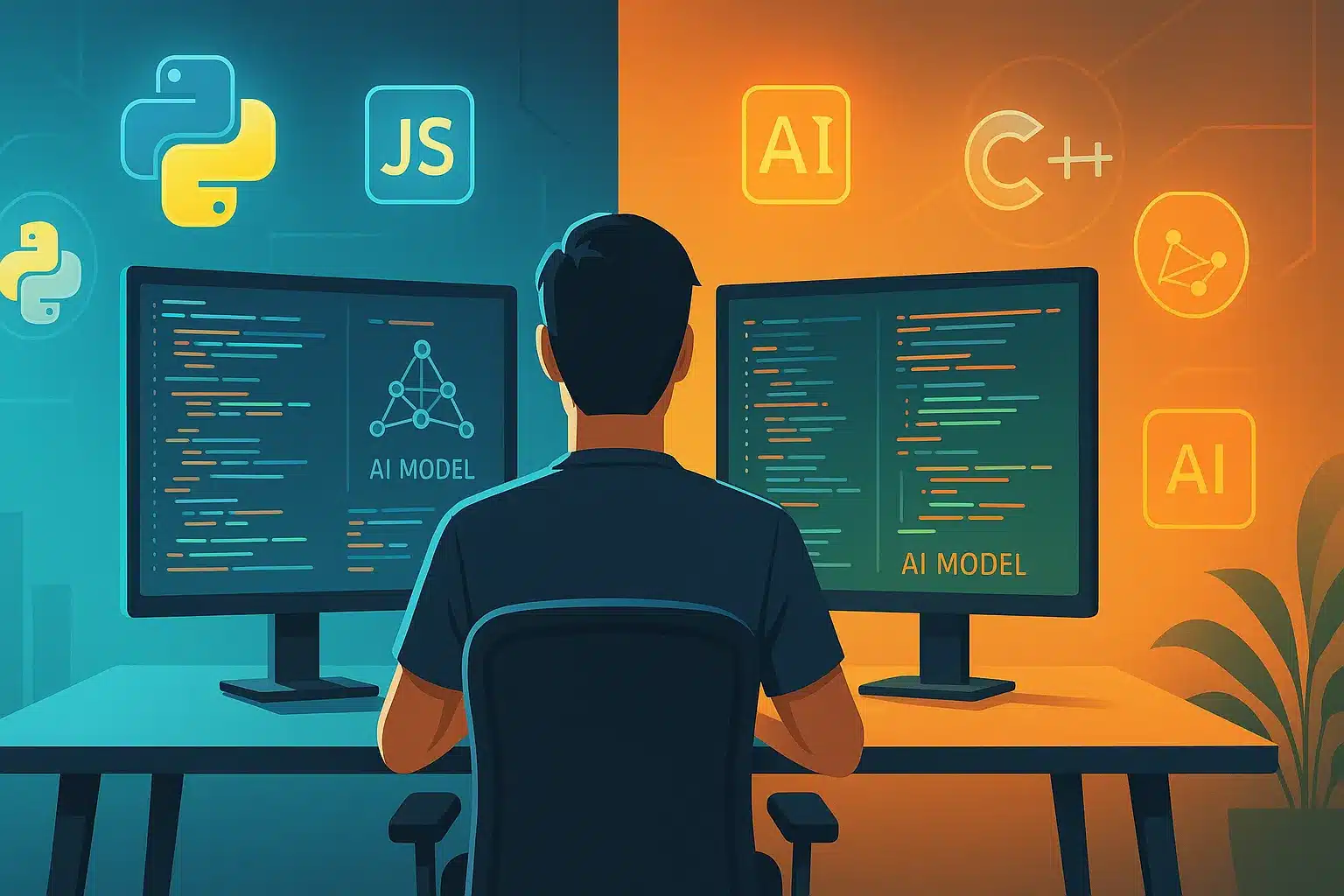The introduction of Large Language Models (LLMs) has transformed the practice of developers writing, debugging, and maintaining code. By 2025, coding assistant have evolved from autocomplete tools into AI pair programmers capable of reasoning about complex software architecture.
With so many models on the marketplace, from recently released proprietary platforms to community-maintained open-source LLMs, developers are wondering: Which is the best LLM for coding right now?
And increasingly, there’s another question—Is the best open source LLM for coding worth choosing over a proprietary one? The open-source movement is gaining momentum, offering transparency, cost savings, and self-hosting options for privacy-critical projects.
What Are LLMs for Coding?
A. Definition and Core Concepts
A Large Language Model is a machine learning system trained on very large datasets of text and/or code. General-purpose LLMs are trained to understand human language, while LLMs designed specifically for coding are trained from huge codes repositories, like GitHub, and learn from each of the syntax, libraries, frameworks, and software development workflows.
B. Capabilities of Coding LLMs
Modern LLMs can:
-
Generate and auto-complete code for various programming languages.
-
Help debug and fix errors reported from compiler or runtime error messages.
-
Provide natural language explanations of advanced code in an onboarding capacity.
-
Create documentation from existing code bases
-
Refactor and simplify code for improved performance and clarity.
Key Considerations for Selecting the Best LLM for Coding

A. Accuracy and Reliability
Models are assessed based on benchmarks such as HumanEval and MBPP that measure code correctness. The best LLM in coding will not just pass syntax checks but will also be able to handle logical correctness for solutions.
B. Supported Programming Languages
Whereas some LLMs may specialize in Python or JavaScript, others can easily manage dozens of languages exactly the same way. Use language support as an indicator for an optimal fit to your primary tech stack.
C. Context Window Size
Context window is a measure of how much code and conversational history the LLM can incorporate. The larger the context window, the more the model can remember and retain context while it parses and understands large projects or large pieces of code.
D. Integration and workflow
It is worth evaluating whether there are IDE plugins, API access, and CI/CD pipeline support, to see if the LLM you have is a good fit for your development workflow.
E. Cost and licensing
Proprietary LLMs usually have some kind of subscription pricing. If you are considering the best open source LLM for coding, terms like free to use, free to customize, etc, and good license terms like an Apache 2.0 license, like a free license, would likely matter to you.
F. Privacy and Security
On-device or self-hosted models ensure sensitive code is never leaving your environment, something that deployment can address with proprietary models, but on device and self-hosted models are where open source solutions really shine.
Top Proprietary LLMs for Coding
A. GPT-4 Turbo / GPT-5 (OpenAI)
-
Strengths: Great reasoning, compact, multi-lingual, good API and IDE integration.
-
Limitations: Expensive at scale, cloud-only.
B. Claude 3.7 Sonnet / Opus (Anthropic)
-
Strengths: Good structured reasoning for response, retains long context**.**
-
Limitations: Fewer partnered apps than Copilot.
C. Gemini 2.5 Pro (Google DeepMind)
-
Strengths: Huge context window for enterprise coding.
-
Limitations: Mostly stuck to the Google Cloud ecosystem.
D. GitHub Copilot (OpenAI-powered)
-
Strengths: Integrated into IDEs, real time suggestions.
-
Limitations: Less customizable.
E. Amazon CodeWhisperer
-
Strengths: Noticed for security scanning, great flow and integration for Amazon AWS ecosystem.
-
Limitations: Feature focused on AWS universe.
V. Top Open Source LLMs for Coding
A. DeepSeek-Coder / DeepSeek R1
-
Highlights: Good benchmark results, released weights for total autonomy to their models.
-
Best for: code bases that are sensitive to privacy.
B. Code Llama (Meta)
-
Highlights: Strong Python/multi-language capabilities, Apache 2.0 license.
-
Best for: Freedom for commercial use without licensing headaches.
C. StarCoder / StarCoder2
-
Highlights: Focus on code generation & explanation.
-
Best for: Education & enterprise documentation.
D. Mistral’s Codestral / Mixtral
-
Highlights: Strong multilingual and structured code reasoning.
-
Best for: Teams working in multiple languages.
E. WizardCoder
-
Highlights: Canvas to allow you to guide step-by-step to solve a problem, good for competitive programming.
-
Best for: Algorithmic challenges and teaching.
Benchmark Comparison of the Best LLMs for Coding
A. HumanEval & MBPP Scores
-
Proprietary leaders (GPT-5**,** Claude Opus) clearly dominate benchmarks.
-
Open-source competitors (DeepSeek-Coder, StarCoder2) ranked a close runner-up.
B. Real-World Performance
Benchmarks only go so far; integration and context size matter most while debugging large, messy projects.
C. Speed & Latency
Smaller models are faster, but large models may better answers that are more accurate and in more detail.
Proprietary vs. Open Source: Which Should You Choose?
A. The Advantages of Proprietary LLMs
-
Best-in-class accuracy
-
Enterprise integrations and support
B. The Advantages of The Best Open Source LLM for coding
-
Self-hosted (privacy)
-
Cost-effective and customizable
-
No vendor lock-in
C. Recommendations
-
Enterprise teams: GPT-5 or Claude Opus for top accuracy.
-
Startups: DeepSeek-Coder or Code Llama for cost savings.
-
Hobbyists: StarCoder2 or WizardCoder for learning.
Future of LLMs for Coding
A. Multimodal LLMs
The next generation of coding assistants will seamlessly integrate code, text, and images to provide much more context.
B. AI Pair Programming
Working directly with AI to collaborate in real time will feel like you are working with a senior engineer.
C. Open Source Growth
Community-based models and deployments will push back against the proprietary nature of the domain and makes the use of LLMs more privacy oriented and flexible.
Conclusion
The best LLM for code in 2025 depends on your priorities, such as, accuracy (believability of responses), costs, or privacy.
For proprietary content like GPT-5 and Claude Opus reasoning and integration is best. The best a-coder open-source LLM (DeepSeek-Coder, Code Llama) is affordable, but you obtain freedom and control.
So, test both proprietary and open-source LLMs against your workflows, and make your choice on actual performance and not on benchmark performance!
Frequently Asked Questions (FAQ)
1. What is the best LLM for coding in 2025?\
In terms of reasoning and accuracy Proprix models like GPT-5 and Claude Opus, are the best.LLMs for source code that prioritize value and privacy are DeepSeek-Coder and Code Llama.
2. Are open-source LLMs good for professional development?\
Yes, they will only get better! Newer open-source models, like StarCoder2 and DeepSeek-Coder, are becoming competitive to proprietary LLMs at many tasks while also providing better control, transparency, and options for self-hosting (deploying a model under your terms on your own computers).
3. How do I choose the right LLM for my workflow?\
Start with accuracy, languages it supports, context window size, integrations, price, and privacy needs. I recommend testing out a few models against real projects before you make a final decision.
4. What benchmarks matter for coding LLMs?\
Benchmarks like HumanEval and MBPP assess functional correctness and problem-solving skills. We would argue that real-world performance and integration into actual workflows are just as important.
5. Which LLMs are safest for privacy-critical projects?\
Self-hosted open-source large language models (LLMs) like DeepSeek-Coder and Mistral’s Codestral mean all code is housed within your infrastructure and, hence, your data is safe.
6. Can LLMs replace human developers?\
No. LLMs were designed to be AI pair programmers, and they are intended to help out with coding, debugging, and documentation while humans will help with architecture, creative problem solving, and the final review.


Leave a Reply